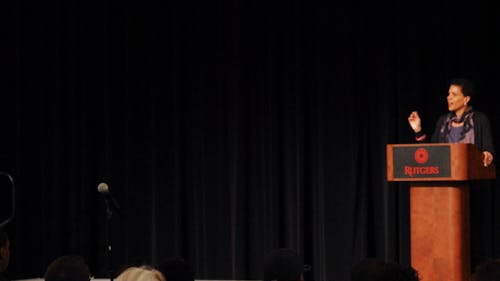Author explains how incarceration system racially discriminates

While many people may think the country left behind the days of segregation long ago, author Michelle Alexander believes the country’s criminal justice system still generates prejudices and injustices similar to Jim Crow laws.
Alexander, who wrote “The New Jim Crow: Mass Incarceration in the Age of Colorblindness,” spoke at the Livingston Student Center last night about the stark racial inequalities still present in our nation.
Rutgers University Programming Association and the Rutgers University MountainView Project — a student organization dedicated to helping at-risk youth through higher education — hosted the discussion.
The country’s war on drugs and tough crime mentality perpetuates the history of racial discrimination, and stunts the progress of blacks after they are released from the prison system, Alexander said.
“For centuries [there has been] a mindset that views black men in particular as a problem to be dealt with, harshly,” she said. “This had led to a brutal war on drugs, a get-tough movement, and to a prison-building boom unprecedented in world history.”
In claiming to deal with the issues of drugs and crime rates, the policies focus primarily on incarcerating a distinct population, she said, reflecting the same tactics used in the historical period of the Jim Crow laws.
“Today there are more African Americans adults under correctional control in prison or jail, on probation or parole, than were enslaved in 1850, the decade before the Civil War began,” she said.
The effects of the criminal justice system will cause more than half of black men to undergo legal discrimination not only while in prison, but for the rest of their lives, Alexander said.
“Once you have been branded a felon, you have been swept into a parallel social universe in which the very civil and human rights others take for granted, no longer apply to you,” she said.
Once convicted of a drug felony, she said a person no longer has the ability to access benefits such as public housing, welfare, food stamps and potential employment.
“What do we expect people released from prison to do? Apparently what we expect them to do is pay hundreds of thousands of dollars in fees, fines, court costs,” she said.
Because of these conditions, she said the system is designed to facilitate a significant return rate, where 70 percent of the people released from prison find themselves back in the system within a few years or even months.
“The challenges associated with mere survival on the outside are so immense,” she said. “So what do we do in the face of all of this?”
The lecture was part of the MountainView Project’s Prisoner Awareness Week, an initiative to highlight the issues surrounding the incarcerated population, said Terrell Blount, a School of Arts and Sciences senior.
He said the University admitted more than 44 previously incarcerated students as a result of the project’s activism. Many of them have excelled academically and plan to enroll in graduate school.
Blount, who benefitted from the efforts of the program, said this is his tenth anniversary of being released from prison after being incarcerated for six years.
“I was counting down the days before I went home and today I sit in class at the desk, not the desk in the prison center, but in the classroom where I count down the days until my graduation,” he said.
Alexander said starting a social and human rights movement would end the mass incarceration problem.
“We have to be willing to tell the truth ... so a great awakening can begin, because unlike the old Jim Crow, there are no signs alerting you to the existence of this new caste system,” she said.
Walter Forston, a School of Arts and Sciences senior, said Alexander’s book is both influential and provocative because it correctly assesses the current situation with the nation’s incarcerated population.
“Looking at the statistics and over the years how they have occurred in the surge in what’s now been called mass incarceration, she makes striking connections that are little too much of a coincidence to slavery and Jim Crow,” Forston said.
He said Alexander connects people in power today with those in the 18th century, and both groups maintained their positions in power by enforcing discriminatory legislation and continuing a caste system in America.
“There were laws in the South that … would exaggerate offenses so people were put in prison for a long time for something that was very trivial,” he said. “You bring it up to where we are now … someone who has [possession] of marijuana [can] go to jail for five years.”
This misrepresentative sentencing is concentrated significantly more in one demographic than the other, Forston said, and statistics show no differences between the use of marijuana among whites and minorities. But in some areas, blacks are 4 to 12 times more likely to get arrested for the crime.
“People walk around and say we live in a post-racial society and since we have a black president, racism doesn’t exist,” he said. “If racism doesn’t exist … then why is there such a disproportion in the number of blacks and Latinos in these prisons?”
Forston said serving five years for possessing $100 worth of marijuana is too long of a sentence.
This labels these offenders as felons, and the stigma dramatically affects chances of receiving job offers, scholarships and college acceptances.
“The difficulties are endless … you will always be labeled a felon … regardless of the seriousness or non-seriousness of your crime. There are very few sustainable jobs, especially in this economic climate that someone will find a means to sustain themselves from unemployment,” he said.



